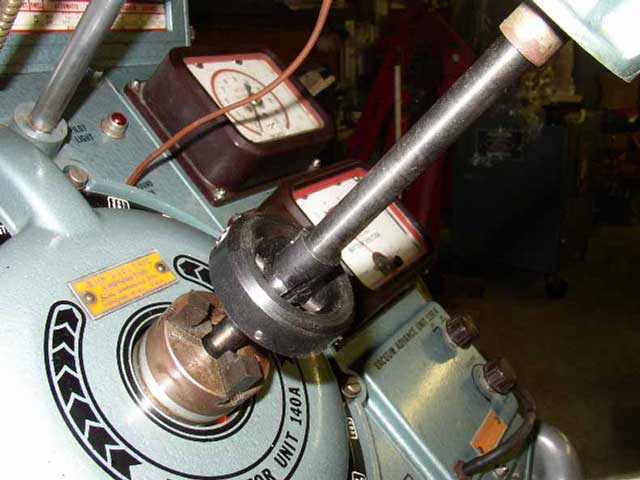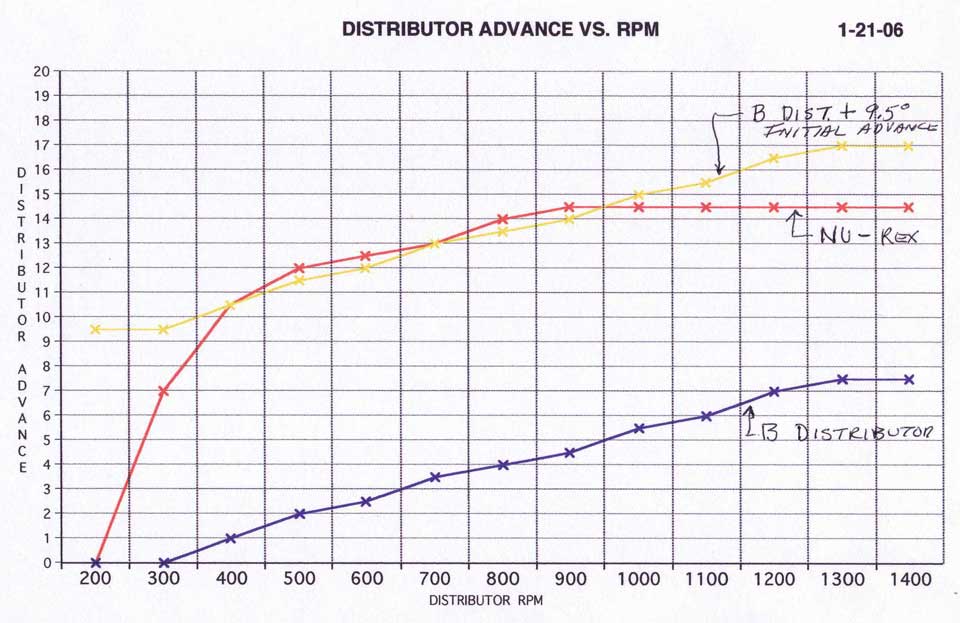
Model A
Ford Garage
Nu-Rex Centrifugal Spark Advance Unit
The Nu-Rex centrifugal spark advance advance unit is a reproduction copy of the original era accessory Phillips Automatic Spark Control. This unit is placed inside the valve chamber in place of the lower distributor shaft, and has the effect of automatically changing the ignition distributor spark timing position as a function of engine RPM, making the stock manual advance lever unnecessary.
As the rotating ring aligns in the horizontal plane, a helix joint between the upper and lower shafts changes the relative angular position of the shafts, thus advancing the upper shaft relative to the lower (driving) shaft.
The geometry of the helix mechanically controls the maximum possible advance to about 30 crankshaft degrees, which is very suitable for our modern fuels, compression ratios, and driving.
The stock Model A distributor was designed by Ford in 1927 to have 40 total crankshaft degrees of possible manual advance capability from initial timing position, in order that the initial spark timing could be set (retarded) at 0 crankshaft degrees (TDC) for enabling starting by hand cranking, in cold weather, and with poor fuels, all on a low speed, low compression engine.
The Model A was never intended or recommended to be driven at full 40 degrees ignition advance (or at 0 degrees full retard!).
By 1932, fuels, roads, speeds, and compression ratios had improved. The improved self-advancing 1932 Model B distributor maxes out at about 32 crankshaft degrees BTDC dynamic spark advance.
The pics and data below were collected by Jim Kellett who ran the Nu-Rex unit on a Sun distributor test machine and collected the advance curve data.

 fordgarage.com
fordgarage.comShown above is the Nu-Rex spark advance unit mounted in the Sun distributor test machine. The Nu-Rex unit weight ring behaves like a gyroscope, and changes the relation between the upper shaft and lower shaft as the rotating ring changes attitude in response to changing RPM.
Click image for a larger view!
The chart above shows the advance curve data recorded for the Nu-Rex unit as well as the Model B distributor. The Model B distributor has an internal centrifugal advance unit.
The initial spark timing position for the Model B is set 19 crankshaft degrees before TDC, which is why the Model B data is shifted 9.5 distributor degrees (distributor turns at half engine speed).


Distributor advance degrees versus distributor RPM.
| Distributor RPM |
Nu-Rex Advance Degrees (distributor) |
||
|---|---|---|---|
| Run 1 | Run 2 | Run 3 | |
| 150 | 0 | 0 | 0 |
| 200 | 0 | 0 | 0 |
| 250 | 4.5 | 4.0 | 4.0 |
| 300 | 7.0 | 7.0 | 7.0 |
| 350 | 9.0 | 9.0 | 9.0 |
| 400 | 11.0 | 11.0 | 10.5 |
| 450 | 12.0 | 12.0 | 12.0 |
| 500 | 12.5 | 12.0 | 12.0 |
| 600 | 13.0 | 12.5 | 12.5 |
| 700 | 13.0 | 13.0 | 13.0 |
| 800 | 14.0 | 14.0 | 14.0 |
| 900 | 14.5 | 14.5 | 14.5 |
| 1000 to 2000 |
flat with values 14.5 to 15.0 | ||
The table above shows the distributor advance degrees versus distributor RPM of the Nu-Rex unit as read on the Sun machine.
The table below has been converted to show the equivalent crankshaft advance degrees versus engine RPM based on the distributor data measured on the Sun machine.
| Engine RPM |
Nu-Rex Advance Degrees (crankshaft) |
||
|---|---|---|---|
| Run 1 | Run 2 | Run 3 | |
| 300 | 0 | 0 | 0 |
| 400 | 0 | 0 | 0 |
| 500 | 9 | 8 | 8 |
| 600 | 14 | 14 | 14 |
| 700 | 18 | 18 | 18 |
| 800 | 22 | 22 | 21 |
| 900 | 24 | 24 | 24 |
| 1000 | 25 | 24 | 24 |
| 1200 | 26 | 25 | 25 |
| 1400 | 26 | 26 | 26 |
| 1600 | 28 | 28 | 28 |
| 1800 | 29 | 29 | 29 |
| 2000 to 4000 |
flat with values 29 to 30 | ||
Thanks to Jim Kellett for sharing the data and charts and pics!
More related information on Ford Garage:
- For more Model A & B related information, use the Site Search box at the top or bottom of this page.
- Model A Phillips Automatic Spark Control Unit
- Model A & B Engine Cam/Valve and Ignition/Spark Timing Discussion
- Model B & Model 46 Distributor Design Details
- Model B & Model 46 Distributor Advance Operation
- Model B & Model 46 Pertronix Ignitor Distributor Timing Procedures
- Model A Remund Pertronix Electronic Ignition Instructions
- Model A, B, & Model 46 Camshaft Gear Timing Cover Differences
- Model A & B Ignition Components Interchange Chart
- Model A Condenser Capacitance
- Model A & B Condenser Details
- Model A Distributor Lower Plate Wiring Solution
- Model A & B & V8 Vacuum Gauge Tuning from ARSCO
- Model A & B & V8 World War II Training Film: Automotive Troubleshooting. 1942 on YouTube
- Model A & B & V8 World War II Training Film #497: Mechanics, Champion Ignition and Spark Plug. c. 1941-1945 on YouTube
Vince Falter
March 2006


